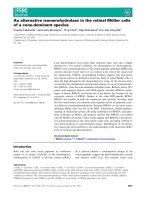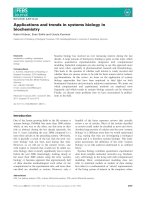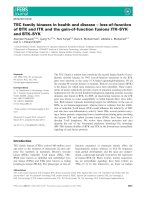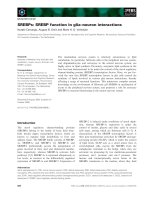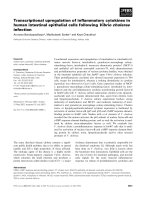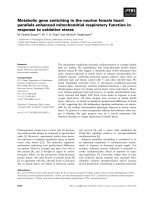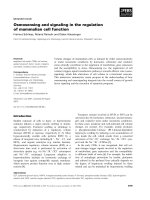Tài liệu Báo cáo khoa học: "Constraints over Lambda-Structures in Semantic Under specification" pptx
Bạn đang xem bản rút gọn của tài liệu. Xem và tải ngay bản đầy đủ của tài liệu tại đây (617.79 KB, 7 trang )
Constraints over Lambda-Structures in Semantic
Underspecification
Markus Egg and Joachim Niehren* and Peter Ruhrberg and Feiyu Xu
Department of Computational Linguistics / *Programming Systems Lab
Universit/it des Saarlandes, Saarbriicken, Germany
{egg, peru, feiyu}~coli, uni-sb, de
niehren~ps, uni-sb, de
Abstract
We introduce a first-order language for seman-
tic underspecification that we call Constraint
Language for Lambda-Structures (CLLS). A A-
structure can be considered as a A-term up
to consistent renaming of bound variables (a-
equality); a constraint of CLLS is an underspec-
ified description of a A-structure. CLLS solves
a capturing problem omnipresent in underspec-
ified scope representations. CLLS features con-
straints for dominance, lambda binding, paral-
lelism, and anaphoric links. Based on CLLS we
present a simple, integrated, and underspecified
treatment of scope, parallelism, and anaphora.
1 Introduction
A central concern of semantic underspecifica-
tion (van Deemter and Peters, 1996) is the un-
derspecification of the scope of variable bind-
ing operators such as quantifiers (Hobbs and
Shieber, 1987; Alshawi, 1990; Reyle, 1993).
This immediately raises the conceptual problem
of how to avoid variable-capturing when instan-
tiating underspecified scope representations. In
principle, capturing may occur in all formalisms
for structural underspecification which repre-
sent binding relations by the coordination of
variables (Reyle, 1995; Pinkal, 1996; Bos, 1996;
Niehren et al., 1997a). Consider for instance the
verb phrase in
(1) Manfred [vF knows every student]
An underspecified description of the composi-
tional semantics of the VP in (1) might be given
along the lines of (2):
(2)
X Cl(Vx(student(x)-+C2(know(Z,
x))))
The meta-variable X in (2) denotes some tree
representing a predicate logic formula which is
underspecified for quantifier scope by means of
two place holders C1 and C2 where a subject-
quantifier can be filled in, and a place holder
Z for the subject-variable. The binding of the
object-variable x by the object-quantifier Vx is
coordinated through the
name
of the object-
variable, namely 'x'. Capturing occurs when
a new quantifier like 3x is filled in C2 whereby
the binding between x and Vx is accidentally
undone, and is replaced with a binding of x by
3x.
Capturing problems raised by variable coordi-
nation may be circumvented in simple cases
where all quantifiers in underspecified descrip-
tions can be assumed to be named by distinct
variables. However, this assumption becomes
problematic in the light of
parallelism
between
the interpretations of two clauses. Consider for
instance the
correction
of (1) in (3):
(3) No, Hans [vP knows every student]
The description of the semantics of the VP in
(3) is given in (4):
(4)
Y=C3(Vy(student(y)-+C4(know( Z', y) ) ) )
But a full understanding of the combined
clauses (1) and (3) requires a grasp of the se-
mantic identity of the two VP interpretations.
Now, the VP interpretations (2) and (4) look
very much Mike but for the different object-
variable, namely 'y' instead of 'x'. This illus-
trates that in cases of parallelism, like in cor-
rections, different variables in parallel quanti-
fied structures have to be matched against each
other, which requires some form of renaming
to be done on them. While this is unprob-
lematic for fully specified structures, it presents
serious problems with underspecified structures
like (2) and (4), as there the names of the vari-
353
ables are crucial for insuring the right bindings.
Any attempt to integrate parallelism with scope
underspecification thus has to cope with con-
flicting requirements on the choice of variable
names. Avoiding capturing requires variables
to be renamed apart but parallelism needs par-
allel bound variables to be named alike.
We avoid all capturing and renaming prob-
lems by introducing the notion of
A-structures,
which represent binding relations without nam-
ing variables. A
A-structure
is a standard pred-
icate logic tree structure which can be con-
sidered as a A-term or some other logical for-
mula up-to consistent renaming of bound vari-
ables (a-equality). Instead of variable names,
a A-structure provides a partial function on
tree-nodes for expressing variable binding. An
graphical illustration of the A-structure corre-
sponding to the A-term Ax.like(x,x) is given (5).
(5) ( ', Axlike(x,x)
Formally, the binding relation of the A-structure
in (5) is expressed through the partial function
A (5) defined by A(5)(v2) = v0 and A(5)(v3) = v0.
We propose a first-order constraint language for
A-structures called CLLS which solves the cap-
turing problem of underspecified scope repre-
sentations in a simple and elegant way. CLLS
subsumes dominance constraints (Backofen et
al., 1995) as known from syntactic processing
(Marcus et al., 1983) with tree-adjoining gram-
mars (Vijay-Shanker, 1992; Rogers and Vijay-
Shanker, 1994). Most importantly, CLLS con-
straints can describe the binding relation of a A-
structure in an underspecified manner (in con-
trast to A-structures like (5), which are always
fully specified). The idea is that A-binding be-
haves like a kind of
rubber band
that can be
arbitraryly enlarged but never broken. E.g., (6)
is an underspecified CLLS-description of the A-
structure (5).
Xo,~*X~
A A(X~)=X4A
.~.?
Xo
Xl:lam(X2)A //lain I X1
(6) X2,~*X3A ' * X2
I
Z3:,ke(X ,Xs)^
,
X4:var A X5:var var,,~.~X4 vat ~ X5
The constraint (6) does not determine a unique
A-structure since it leaves e.g. the space be-
tween the nodes X2 and X3 underspecified.
Thus, (6) may eventually be extended, say, to
a constraint that fully specifies the A-structure
for the A-term in (7).
(7)
Ay.Az.and(person(y), like(y, z) )
Az intervenes between Ay and an occurrence of
y when extending (6) to a representation of (7)
without the danger of undoing their binding.
CLLS is sufficiently expressive for an integrated
treatment of semantic underspecification, par-
allelism, and anaphora. To this purpose it
provides parallelism constraints (Niehren and
Koller, 1998) of the form
X/X',,~Y/Y I
reminis-
cent to equality up-to constraints (Niehren et
al., 1997a), and anaphoric bindings constraints
of the form
ante(X)=X'.
As proved in (Niehren and Koller, 1998), CLLS
extends the expressiveness of context unifica-
tion (Niehren et al., 1997a). It also extends
its linguistic coverage (Niehren et al., 1997b)
by integrating an analysis of VP ellipses with
anaphora as in (Kehler, 1995). Thus, the cov-
erage of CLLS is comparable to Crouch (1995)
and Shieber et al. (1996). We illustrate CLLS
at a benchmark case for the interaction of scope,
anaphora, and ellipsis (8).
(8) Mary read a book she liked before Sue did.
The paper is organized as follows. First, we
introduce CLLS in detail and define its syntax
and semantics. We illustrate CLLS in sec. 3 by
applying it to the example (8) and compare it
to related work in the last section.
2 A Constraint Language for
A-Structures (CLLS)
CLLS is an ordinary first-order language inter-
preted over A-structures. A-structures are par-
ticular predicate logic tree structures we will in-
troduce. We first exemplify the expressiveness
of CLLS.
2.1 Elements of CLLS
A A-structure is a tree structure extended by
two additional relations (the binding and the
linking relation). We represent A-structures
as graphs. Every A-structure characterizes a
unique A-term or a logical formula up to consis-
tent renaming of bound variables (a-equality).
E.g., the A-structure (10) characterizes the
higher-order logic (HOL) formula (9).
354
(9) (many(language))(Ax.speak(x)(jolm))
(10)
many ~
Two things are important here: the label '~'
represents explicitly the operation of function
application, and the binding of the variable x by
the A-operator Ax is represented by an explicit
binding relation
A between two nodes, labelled
as var and lain. As the binding relation is ex-
plicit, the variable and the binder need not be
given a name or index such as x.
We can fully describe the above A-structure
by means of the constraints for immediate
dominance and labeling
X:f(X1, , Xn),
(e.g.
X1:@(X2,)(3) and X3:lam(X4) etc.) and bind-
ing constraints A(X)=Y. It is convenient to dis-
play such constraints graphically, in the style of
(6). The difference of graphs as constraints and
graphs as A-structures is important since under-
specified structures are always seen as descrip-
tions of the A-structures that satisfy them•
Dominance. As a means to underspecify A-
structures, CLLS employs constraints for
domi-
nance X~*Y.
Dominance is defined as the tran-
sitive and reflexive closure of immediate dom-
inance. We represent dominance constraints
graphically as dotted lines. E.g., in (11) we have
the typical case of undetermined scope. It is
analysed by constraint (12), where two nodes
X1 and X2, lie between an upper bound Xo
and a lower bound X3. The graph can be lin-
earized by adding either a constraint
XI~*X2
or
X2~*X1,
resulting in the two possible scop-
ing readings for the sentence (11).
(11) Every linguist speaks two Asian
languages.
(12)
".X.o.
•" ~X
' 2
e_l
t_a_l
,'
.x4
| "'"' " l
| "
• ,,
~ var~-~
speak
Parallelism. (11) may be continued by an el-
liptical sentence, as in (13).
(13) Two European ones too.
We analyse elliptical constructions by means of
a parallelism constraint
of the form
(14)
X,/Xp~YdY p
which has the intuitive meaning that the seman-
tics Xs of the
source clause
(12) is
parallel
to
the semantics Yt of the elliptical
target clause,
up-to
the exceptions Xp and
Yp,
which are the
semantic representations of the so called
paral-
lel elements
in source and target clause. In this
case the parallel elements are the two subject
NPs.
(11) and (13) together give us a 'Hirschbiihler
sentence' (Hirschbiihler, 1982), and our treat-
ment in this case is descriptively equivalent to
that of (Niehren et al., 1997b). Our paral-
lelism constraints and their
equality up-to
con-
straints have been shown to be (non-trivially)
intertranslatable (Niehren and Koller, 1998) if
binding and linking relations in A-structures are
ignored.
For the interaction of binding with parallelism
we follow the basic idea that binding relations
should be isomorphic between two similar sub-
structures. The cases where anaphora interact
with ellipsis are discussed below.
Anaphoric links. We represent anaphoric
dependencies in A-structures by another explicit
relation between nodes, the
linking
relation. An
anaphor (i.e. a node labelled as
ana)
may be
linked to an antecedent node, which may be la-
belled by a name or var, or even be another
anaphor. Thus, links can form chains as in (15),
where a constraint such as
ante(X3)=X2
is rep-
resented by a dashed line from X3 to X2.
The constraint (15) analyzes (16), where the
second pronoun is regarded as to be linked to
the first, rather than linked to the proper name:
(15)
like
¢~~~i ~2
rnother_of ~
ana
~ X3
(16) John i said he~ liked hisj mother
355
In a semantic interpretation of A-structures,
analoguously to a semantics for lambda terms, 1
linked nodes get identical denotations. Intu-
itively, this means they are interpreted as if
names, or variables with their binding relations,
would be copied down the link chain. It is cru-
cial though not to use such copied structures
right away: the link relation gives precise con-
trol over strict and sloppy interpretations when
anaphors interact with parallelism.
E.g., (16) is the source clause of the many-
pronouns-puzzle, a problematic case of interac-
tion of ellipsis and anaphora. (Xu, 1998), where
our treatment of ellipsis and anaphora was de-
veloped, argues that link chains yield the best
explanation for the distribution of strict/sloppy
readings involving many pronouns.
The basic idea is that an elided pronoun can
either be linked to its parallel pronoun in the
source clause (referential parallelism) or be
linked in a structurally parallel way (structural
parallelism). This analysis agrees with the pro-
posal made in (Kehler, 1993; Kehler, 1995). It
covers a series of problematic cases in the lit-
erature such as the many-pronouns-puzzle, cas-
caded ellipsis, or the five-reading sentence (17):
(17) John revised his paper before the teacher
did, and so did Bill
The precise interaction of parallelism with bind-
ing and linking relations is spelled out in sec.
2.2.
2.2 Syntax and Semantics of CLLS
We start with a set of labels E=
{@2,
lam I ' var 0 ' ana 0 '
before 2,
maryO, readO,,,
.},
ranged over by
]ji,
with arity i which may be
omitted. The syntax of CLLS is given by:
::=
XJ(Xl, ,X,)
(]J"ES)
I
X<*Y
I A(x)=Y
I
ante(X)=Y
I
X/X'~Y/Y'
[ ~ A~'
The semantics of CLLS is given in terms
of first order structures L, obtained from
underlying tree structures, by adding rela-
tions eL for each CLLS relation symbol ¢ E
{~*, A(.)= ", ante(.)=., ./.~-/-, :@, :lam, :vat, }.
1We abstain from giving such a semantics here, as we
would have to introduce types, which are of no concern
here, to keep the semantics simple.
A (finite) tree structure, underlying L, is given
by a set of
nodes u, u',
connected by
paths
~r, ~ff, (possibly empty words over positive in-
tegers), and a
labelling ]junction I
from nodes
to labels. The number of daughters of a node
matches the arity of its label. The relationship
Y:fL(Vl, , Yn)
holds iff
l(v)=]j
and
v.i = vi
for
i = 1 n, where v.~r stands for the node that is
reached from v by following the path 7r (if de-
fined). To express that a path lr is defined on
a node v in L we write
v.rSL.
We write ~r<r'
for ~r being an initial segment of 7d. The
domi-
nance
relation v<~v' holds if 37r v.Tr =
v'.
If ~r
is non-empty we have
proper dominance v<+v '.
A A-structure L
is a tree structure with two
(partially functional) binary relations AL(')= ",
for
binding,
and anteL(')=', for anaphor-to-
antecedent
linking.
We assume that the follow-
ing conditions hold: (1) binding only holds be-
tween variables (nodes labelled var) to A-binders
(nodes labelled lain); (2) every variable has ex-
actly one binder; (3) variables are dominated
by their binders; (4) only anaphors (nodel la-
belled ana) are linked to antecendents; (2) ev-
ery anaphor has exactly one antecendent; (5)
antecedents are terminal nodes; (6) there are
no cyclic link chains; (7) if a link chain ends at
a variable then each anaphor in the chain must
be dominated by the binder of that variable.
The not so straight forward part of the seman-
tics of CLLS is the notion of
parallelism,
which
we define for any given A-structure L as follows:
iff there is a path ~r0 such that:
1. rr0 is the "exception path" from the top
node of the parallel structures the the two
exception positions:
v{=Vl.~ro A v~=v2.~ro
2. the two
contexts,
which are the trees be-
low Vl and v2 up-to the trees below the ex-
ception positions v{ and v~, must have the
same structure and labels:
Vr -~0<r ~ ((v,.~$L ~ v2.rSL)A
(Vl.Tr.~L =:~ l(Vl.Tr ) l(v2.Tr))))
3. there are no 'hanging' binders from the con-
texts to variables outside them:
VvVv'
*
+
' * ' AL(v')=v)
~(Vl<~LV<~ L Vl <~LV
A
4. binding is structurally isomorphic within
the two contexts:
356
V rr V rr' -~ir o < ~r A vl . Tr.L L A -~'tr o <_Tr' A vl . lr' J~ L
:=~
5. two variables in identical positions within
their context and bound outside their con- ~_.~.:y,. "
text must be bound by the same binder: , ~'~. I~-~
v,,w-(,,o>,, /-'% :;*-1
x.,
(AL(Vl.rr)=v ¢~ AL(v2.~r)=v)
~'ana ?
X,2~ ~
:.
6. two anaphors in identical positions within ~x
their context must have isomorphic links x ".
resents the semantics of the elided part of the
target clause.)
(18) X9"
'
b~x t
• " , xTg o
:
:
:
within their context, or the target sentence
anaphor is linked to the source sentence
anaphor:
VvVTr -mr0_<Tr A Vl.Tr,~L A anteL(Vl.Tr)=v =:>
(37r'(v=vl.~r'A-=rr0<rr'AanteL (v=.rr) v2nr')
V anteL(u2.r)=Ul.rr)
3 Interaction of quantifiers,
anaphora, and ellipsis
In this section, we will illustrate our analysis
of a complex case of the interaction of scope,
anaphora, and ellipsis. In the case (8), both
anaphora and quantification interact with ellip-
sis.
(8) Mary read a book she liked before Sue did.
(8) has three readings (see (Crouch, 1995) for
a discussion of a similar example). In the first,
the indefinite NP a book she liked takes wide
scope over both clauses (a particular book liked
by Mary is read by both Mary and Sue). In the
two others, the operator before outscopes the in-
definite NP. The two options result from the two
possibilities of reconstructing the pronoun she
in the ellipsis interpretation, viz., 'strict' (both
read some book that Mary liked) and 'sloppy'
(each read some book she liked herself).
The constraint for (8), displayed in (18), is an
underspecified representation of the above three
readings. It can be derived in a compositional
fashion along the lines described in (Niehren et
al., 1997b). Xs and Xt represent the semantics
of the source and the target clause, while X16
and X21 stand for the semantics of the paral-
lel elements (Mary and Sue) respectively. For
readability, we represent the semantics of the
complex NP a book she liked by a triangle dom-
inated by X2, which only makes the anaphoric
content
212
of the pronoun she within the NP
explicit. The anaphoric relationship between
the pronoun she and Mary is represented by the
linking relation between X12 and X16. (X20 rep-
¢
read ~~7~1 ~Xz6
Xs/XI6~X~/X21
The first reading, with the NP taking wide
scope, results when the relative scope between
XI and XI5 is resolved such that XI dominates
X15. The corresponding solution of the con-
straint is visualized in (19).
(19)
za, x=,
read ~'~ var~ X"z~ read ~ var~'~ j
The parallelism constraint
Xs/Xl6,,~Xt/X21
is
satisfied in the solution because the node Xt
dominates a tree that is a copy of the tree dom-
inated by Xs. In particular, it contains a node
labelled by var, which has to be parallel to Xlr,
and therefore must be A-linked to X3 too.
The other possible scoping is for XlS to domi-
nate X1. The two solutions this gives rise to are
drawn in (20) and (21). Here X1 and the in-
terpretation of the indefinite NP directly below
enter into the parallelism as a whole, as these
nodes lie below the source node Xs. Thus, there
are two anaphoric nodes: X12 in the source and
its 'copy' II12 in the target semantics. For the
copy to be parallel to XI2 it can either have
a link to X12 to have a same referential value
(strict reading, see (20)) or a link to X21 that
is structurally parallel to the link from X12 to
X16, and hence leads to the node of the parallel
element Sue (sloppy reading, see (21)).
357
(20) ~x,
I"" ~"r, ary.,, X~6"~. '
~/sue * _X
4 Related Work
CLLS allows a uniform and yet internally struc-
tured approach to semantic ambiguity. We use
a single constraint formalism in which to de-
scribe different kinds of information about the
meaning of an utterance. This avoids the prob-
lems of order dependence of processing that for
example Shieber et al. (1996) get by inter-
leaving two formalisms (for scope and for el-
lipsis resolution). Our approach follows Crouch
(1995) in this respect, who also includes par-
allelism constraints in the form of substitution
expressions directly into an underspecified se-
mantic formalism (in his case the formalism of
Quasi Logical Forms QLF). We believe that the
two approaches are roughly equivalent empiri-
cally. But in contrast to CLLS, QLF is not for-
malised as a general constraint language over
tree-like representations of meaning. QLF has
the advantage of giving a more direct handle
on meanings themselves - at the price of its rel-
atively complicated model theoretic semantics.
It seems harder though to come up with solu-
tions within QLF that have an easy portability
across different semantic frameworks.
We believe that the ideas from CLLS tie in quite
easily with various other semantic formalisms,
such as UDRT (Reyle, 1993) and MRS (Copes-
take et al., 1997), which use dominance relations
similar to ours, and also with theories of Logical
Form associated with GB style grammars, such
as (May, 1977). In all these frameworks one
tends to use variable-coordination (or coindex-
ing) rather than the explicit binding and linking
relations we have presented here. We hope that
these approaches can potentially benefit from
the presented idea of rubber bands for binding
and linking, without having to make any dra-
matic changes.
Our definition of parallelism implements some
ideas from Hobbs and Kehler (1997) on the be-
havior of anaphoric links. In contrast to their
proposal, our definition of parallelism is not
based on an abstract notion of similarity. Fur-
thermore, CLLS is not integrated into a general
theory of abduction. We pursue a more modest
aim at this stage, as CLLS needs to be con-
nected to "material" deduction calculi for rea-
soning with such underspecified semantic rep-
resentation in order to make progress on this
front. We hope that some of the more ad hoc
features of our definition of parallelism (e.g. ax-
iom 5) may receive a justification or improve-
ment in the light of such a deeper understand-
ing.
Context Unification. CLLS extends the
expressiveness of context unification (CU)
(Niehren et al., 1997a), but it leads to a more
direct and more structured encoding of seman-
tic constraints than CU could offer. There are
three main differences between CU and CLLS.
1) In CLLS variables are interpreted over nodes
rather than whole trees. This gives us a di-
rect handle on occurrences of semantic material,
where CU could handle occurrences only indi-
rectly and less efficiently. 2) CLLS avoids the
capturing problem. 3) CLLS provides explicit
anaphoric links, which could not be adequately
modeled in CU.
The insights of the CU-analysis in (Niehren
et al., 1997b) carry over to CLLS, but the
awkward second-order equations for expressing
dominance in CU can be omitted (Niehren and
Koller, 1998). This omission yields an enormous
simplification and efficiency gain for processing.
Tractability. The distinguishing feature of
our approach is that we aim to develop ef-
ficiently treatable constraint languages rather
than to apply maximally general but intractable
formalisms. We are confident that CLLS can be
implemented in a simple and efficient manner.
First experiments which are based on high-level
concurrent constraint programming have shown
promising results.
358
5 Conclusion
In this paper, we presented CLLS, a first-order
language for semantic underspecification. It
represents ambiguities in simple underspecified
structures that are transparent and suitable for
processing. The application of CLLS to some
difficult cases of ambiguity has shown that it is
well suited for the task of representing ambigu-
ous expressions in terms of underspecification.
Acknowledgements
This work was supported by the SFB 378
(project CHORUS) at the Universit~t des Saar-
landes. The authors wish to thank Manfred
Pinkal, Gert Smolka, the commentators and
participants at the Bad Teinach workshop on
underspecification, and our anonymous review-
ers.
References
Hiyan Alshawi. 1990. Resolving quasi logical
form.
Computational Linguistics,
16:133-144.
R. Backofen, J. Rogers, and K. Vijay-Shanker.
1995. A first-order axiomatization of the theory
of finite trees.
J. Logic, Language, and Informa-
tion,
4:5-39.
Johan Bos. 1996. Predicate logic unplugged. In
Proceedings lOth Amsterdam Colloquium,
pages
133-143.
Ann Copestake, Dan Flickinger, and Ivan
Sag. 1997. Minimal Recursion Seman-
tics. An Introduction. Manuscript, avail-
able
at ftp ://csli-ftp. stanford, edu/
linguist ic s/sag/mrs, ps. gz.
Richard Crouch. 1995. Ellipsis and quantifica-
tion:
A substitutional approach. In
Proceedings
EACL'95,
pages 229-236, Dublin.
Paul Hirschbiihler. 1982. VP deletion and
across the board quantifier scope. In J. Puste-
jovsky and P. Sells, editors,
NELS 12,
Univ. of
Massachusetts.
Jerry R Hobbs and Andrew Kehler. 1997. A
theory of parallelism and the case of VP-ellipsis.
In
Proceedings A CL '97,
pages 394-401, Madrid.
J.R. Hobbs and S. Shieber. 1987. An algo-
rithm for generating quantifier scoping.
Com-
putational Linguistics,
13:47-63.
Andrew Kehler. 1993. A discourse copying al-
gorithm for ellipsis and anaphora resolution. In
Proceedings of EA CL.
Andrew Kehler. 1995.
Interpreting Cohesive
Forms in the Context of Discourse Inference.
Ph.D. thesis, Harvard University.
M. Marcus, D. Hindle, and M. Fleck. 1983. D-
theory: Talking about talking about trees. In
Proceedings of the 21st ACL,
pages 129-136.
Robert May. 1977.
The Grammar of Quantifi-
cation.
Doctoral dissertation, MIT, Cambridge
Mass.
Joachim Niehren and Alexander Keller. 1998.
Dominance Constraints in Context Unification,
January. http://w~w, ps. un±- sb. de/Papers/
abstract s/Dominance, html.
J. Niehren, M. Pinkal, and P. Ruhrberg. 1997a.
On equality up-to constraints over finite trees,
context unification, and one-step rewriting.
In
Proceedings 14th CADE.
Springer-Verlag,
Townsville.
J. Niehren, M. Pinkal, and P. Ruhrberg. 1997b.
A uniform approach to underspecification and
parallelism. In
Proceedings A CL '97,
pages 410-
417, Madrid.
Manfred Pinkal. 1996. Radical underspecifica-
tion. In
Proceed. lOth Amsterdam Colloquium,
pages 587-606.
Uwe Reyle. 1993. Dealing with ambiguities
by underspecification: construction, represen-
tation, and deduction.
Journal of Semantics,
10:123-179.
Uwe Reyle. 1995. Co-indexing labelled DRSs
to represent and reason with ambiguities. In
S. Peters and K. van Deemter, editors,
Semantic
Ambiguity and Underspecification.
CSLI Publi-
cations, Stanford.
J. Rogers and K. Vijay-Shanker. 1994. Extract-
ing trees from their descriptions: an application
to tree-adjoining grammars.
Computational In-
telligence,
10:401-421.
Stuart Shieber, Fernando Pereira, and Mary
Dalrymple. 1996. Interaction of scope and el-
lipsis.
Linguistics and Philosophy,
19:527-552.
Kees van Deemter and Stanley Peters. 1996.
Semantic Ambiguity and Underspecification.
CSLI, Stanford.
K. Vijay-Shanker. 1992. Using description of
trees in tree adjoining grammar framework.
Computational Linguistics,
18.
Feiyu Xu. 1998. Underspecified representa-
tion and resolution of ellipsis. Master's thesis,
Universit~it des Saarlandes. http ://www. col±.
uni- sb. de/'feiyu/thesis, html.
359
